英汉语言对比研究期末复习重点
英汉语法对比
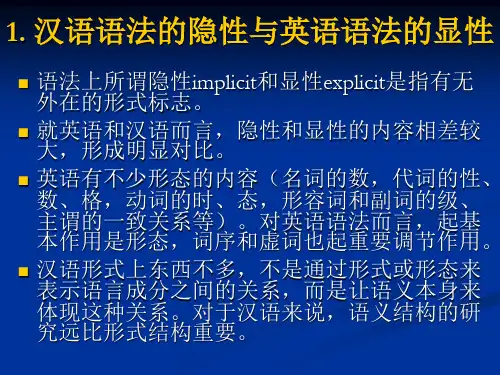
(3)词法与句法之间的对应 英语传统语法分为词法和句法。词法依据形态;
句法依据功能。由于形态是功能的表现形式, 因此,这两者的结果是一致的,表现在词法和 句法可以对称,词类和句子成分之间有较明显 的对应关系。徐通锵将这样的语法称为双轨制 语法结构。
英语语法强调避免语法错误,句子结构紧凑,关 系和层次分明。
语句分析顺序,英语是从结构到语义。而汉语是 从语义到结构。
➢ 王冕七岁上死了父亲。
➢ 中国队大胜美国队/中国队大败美国队。
(2)语法单位的清晰与模糊
英语传统语法把语言单位分为词与句子两 级,在此基础上,把语法分为词法和句法, 结构主义语法把语言单位分为语素、词、 短语、分句、句子五级。在英语中,由于 有形态帮助,各级语法单位之间的界限是 清晰的。汉语则不然。
事理上的因果律:先因后果、先假设后可能、 先条件后结果。汉语复句基本上都是先从后 主,即表示原因、条件、假设等一律在前, 表示结果等一律在后。当把原因、条件等看 做补充说明时,根据心理上的重轻律,可以 把它们放在主句之后。
And he knew how ashamed he would have been if she had known his mother and the kind of place in which he was born, and the kind of people among whom he was born.
有形式上保证,英语短语和从句作修饰语 可前可后;主谓倒装、宾语前置都不会被 误解;据连词判断主从;据时态可判断时 间先后。形态丰富的语言不很讲究词序。
句中的作用。
汉语的声调对词和短语的语序起重要作用。
英汉语言对比复习资料
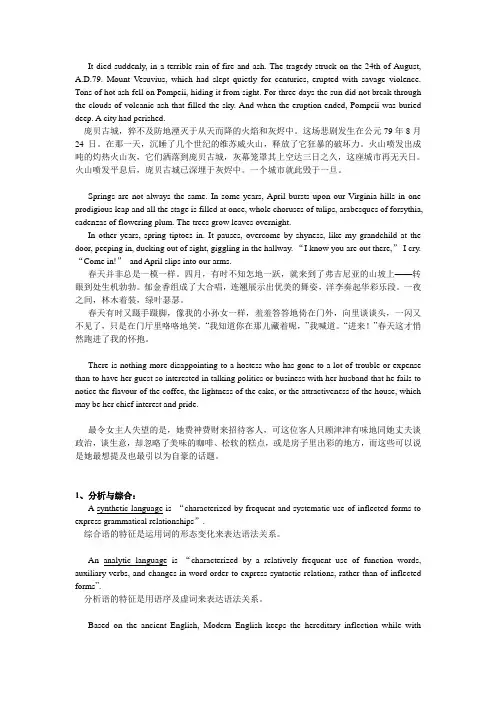
It died suddenly, in a terrible rain of fire and ash. The tragedy struck on the 24th of August, A.D.79. Mount Vesuvius, which had slept quietly for centuries, erupted with savage violence. Tons of hot ash fell on Pompeii, hiding it from sight. For three days the sun did not break through the clouds of volcanic ash that filled the sky. And when the eruption ended, Pompeii was buried deep. A city had perished.庞贝古城,猝不及防地湮灭于从天而降的火焰和灰烬中。
这场悲剧发生在公元79年8月24日。
在那一天,沉睡了几个世纪的维苏威火山,释放了它狂暴的破坏力。
火山喷发出成吨的灼热火山灰,它们洒落到庞贝古城,灰幕笼罩其上空达三日之久,这座城市再无天日。
火山喷发平息后,庞贝古城已深埋于灰烬中。
一个城市就此毁于一旦。
Springs are not always the same. In some years, April bursts upon our Virginia hills in one prodigious leap and all the stage is filled at once, whole choruses of tulips, arabesques of forsythia, cadenzas of flowering plum. The trees grow leaves overnight.In other years, spring tiptoes in. It pauses, overcome by shyness, like my grandchild at the door, peeping in, ducking out of sight, giggling in the hallway. “I know you are out there,”I cry. “Come in!”and April slips into our arms.春天并非总是一模一样。
《英汉对比研究》笔记
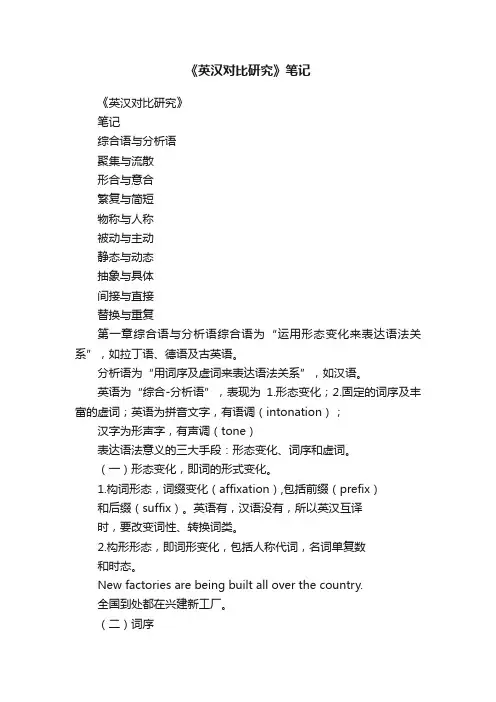
《英汉对比研究》笔记《英汉对比研究》笔记综合语与分析语聚集与流散形合与意合繁复与简短物称与人称被动与主动静态与动态抽象与具体间接与直接替换与重复第一章综合语与分析语综合语为“运用形态变化来表达语法关系”,如拉丁语、德语及古英语。
分析语为“用词序及虚词来表达语法关系”,如汉语。
英语为“综合-分析语”,表现为1.形态变化;2.固定的词序及丰富的虚词;英语为拼音文字,有语调(intonation);汉字为形声字,有声调(tone)表达语法意义的三大手段:形态变化、词序和虚词。
(一)形态变化,即词的形式变化。
1.构词形态,词缀变化(affixation),包括前缀(prefix)和后缀(suffix)。
英语有,汉语没有,所以英汉互译时,要改变词性、转换词类。
2.构形形态,即词形变化,包括人称代词,名词单复数和时态。
New factories are being built all over the country.全国到处都在兴建新工厂。
(二)词序形态变化越多的语言,词序越灵活,反之亦然。
英语词序比汉语灵活的一个表现就是英语中的倒装句。
原因就是“形态变化”和“连接词”;而中文缺乏形态变化,少用或不用连接词,词序较固定。
形态变化规则要求句中词语之间保持语法关系一致,只要词语之间前后呼应,就容易灵活安排;汉语无这种一致的关系,只能按照表意的需要排序词序。
a)He had to quit the position and went in exile, having beendeprived of his power.他被剥夺了权力之后,只好离职,流落他乡。
b)a very important questiona question of great importance一个很重要的问题c)at an unprecedented speedat a speed unprecedented以空前的速度d)There is no inconsistence in what he said.There is nothing inconsistent in what he said.他说的话并没有前后矛盾之处。
英汉语言文化比较期末重点
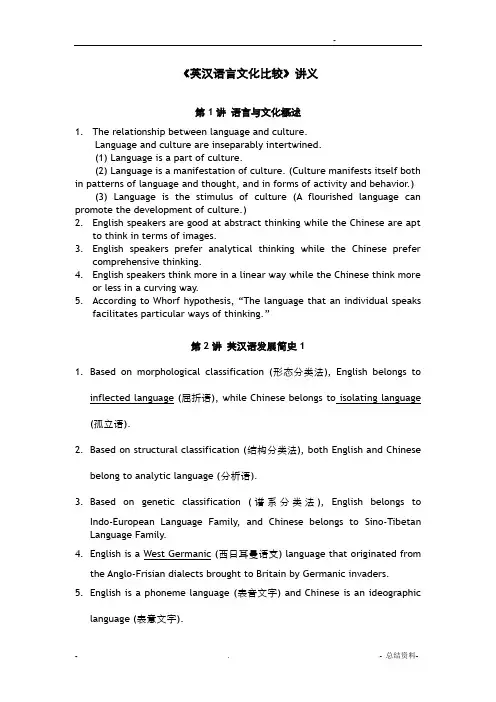
《英汉语言文化比较》讲义第1讲语言与文化概述1.The relationship between language and culture.Language and culture are inseparably intertwined.(1) Language is a part of culture.(2) Language is a manifestation of culture. (Culture manifests itself both in patterns of language and thought, and in forms of activity and behavior.)(3) Language is the stimulus of culture (A flourished language can promote the development of culture.)2.English speakers are good at abstract thinking while the Chinese are aptto think in terms of images.3.English speakers prefer analytical thinking while the Chinese prefercomprehensive thinking.4.English speakers think more in a linear way while the Chinese think moreor less in a curving way.5.According to Whorf hypothesis, “The language that an individual speaksfacilitates particular ways of thinking.”第2讲英汉语发展简史11.Based on morphological classification (形态分类法), English belongs toinflected language (屈折语), while Chinese belongs to isolating language (孤立语).2.Based on structural classification (结构分类法), both English and Chinesebelong to analytic language (分析语).3.Based on genetic classification (谱系分类法), English belongs toIndo-European Language Family, and Chinese belongs to Sino-Tibetan Language Family.4.English is a West Germanic (西日耳曼语支) language that originated fromthe Anglo-Frisian dialects brought to Britain by Germanic invaders.5.English is a phoneme language (表音文字) and Chinese is an ideographiclanguage (表意文字).6.The first people in England about whose language we have definiteknowledge are the Celts.7.After the Norman Conquest, English entered the period of Middle English.8.The period from 450 to 1150 is known as Old English. From 1150 to 1500the language is known as Middle English. The language since 1500 is called Modern English (1500-1700, early Modern English, 1700 until now, later Modern English).9.The main differences between Chinese words and English words: a)Letters in English are like strokes in Chinese. b) Morphemes in English are like radicals in Chinese. c) Chinese associative compounds (会意字) are like English compound words.第3讲英汉语发展简史21.Chinese and most related languages share features that make them unlikemost Western languages: They are monosyllabic, have even less inflection than English, and are tonal.2.In Chinese, a syllabic structure has three essential components: initials(声母), finals (韵母), and tones (声调). Chinese pinyin system has 21 initial consonants, 36 final vowels and 4 tones.3.According to Xu Shen’s (许慎) research, Chinese characters can be dividedinto six groups: 1) Pictographs (≈4%) 象形; 2) Ideographs (≈1%) 指事; 3) Logical Aggregates (≈13%) 会意; 4) Phonetic Complexes (≈82%) 形声; 5) Associative Transformations (a small portion) 转注; 6) Borrowings (a small portion) 假借.第4讲英汉语构词法1.Word formation in English:1)Compounding (合成法): T wo or more words are joined together toform a new word. (For example: home + work →homework)2)Prefixation (前缀法): Prefixation is the formation of new words byadding prefixes to stems. Prefixes do not generally change the word-class of the stem but only modify its meaning. (For example:Pejorative prefixes (贬义前缀): mal-, pseudo-, mis-, ill-).3)Suffixation (后缀法): Suffixation is the formation of new words byadding suffixes to stems. Unlike prefixes which primarily change the meaning of the stem, the primary function of suffixes is to change the grammatical function of stems.4)Conversion (转化法): Conversion is a word-formation whereby a wordof a certain word-class is shifted into a word of another without the addition of an affix. It is also called zero derivation (零位派生). (For example: 1) Problems snowballed by the hour. 2) Sandwich the two bread halves together and cut into 1-inch-wide slices.)5)Shortening (缩略法)6)Blending (拼缀法): Blending is a process of word-formation in which anew word is formed by combining parts of two words. The result of such a process is called a blend. Blending is a process of both compounding and abbreviation. For example, smog (smoke+fog).7)Back-formation (逆成法): a process of word-formation by which aword is created by the deletion of a supposed suffix. It is also known as a reverse derivation.8)Eponyms9)T oponyms2.Word formation in Chinese:1)The overwhelming majority of the Old-Chinese morphemes aremono-syllabic.2)61% of the 3,000 most commonly used Chinese words are disyllabic.3)Chinese prefixes mostly involve morphemes such as 老, 小, 第, and初.4)Some so-called Chinese suffixes are added as a way of nominalization,like 度, 性, etc.第5讲英汉词语的文化涵比较11.In Chinese, the word xīn (心) that primarily denotes the heart organ mayalso refer to the “organ for thinking”and the “seat of thought and emotions”.2.In contrast, according to the Western view, heart is seen as the center ofemotions/feelings and the head (the locus of the brain with which the mind is associated) as the center of thought.3.Based on the metaphor “heart as a physical entity”, the following wordsare formed in Chinese: 心房, 心窝, 心田, 心地, and 心弦.4.Research proves that if a language only has two color words, they must beblack and white; if the language has the third color word, it must be red;if it has the fourth one, it must be yellow or green.第6讲英汉词语的文化涵比较21.Dog has a negative connotation in “a dog in the manger”.2.Traditionally, people have talked about “fixed expressions”, stressing thefixedness of these expressions, but corpus studies have shown that many of the phrases can actually be varied.3.An idiom is a fixed or semi-fixed expression whose meaning cannot bededuced from its parts. But very few idioms are 100% fixed.第7讲英语抽象名词和汉语具体名词1.The plural forms of abstract English nouns often have the function ofconcretization, for example, ratings, attractions and breakdowns.第8讲形合与意合1.Hypotaxis (形合): The dependent or subordinate relationship of clauseswith connectives. For example: It was cold because the snows came.2.Parataxis (意合): The arranging of clauses or phrases without connectivesshowing the relations between them. For example: It was cold; the snows came.第9讲英汉句法比较1. A topic-prominent language is a language that organizes its syntax toemphasize the topic–comment structure of the sentence. Chinese is considered to be a topic-prominent language, where the topic of the sentence takes precedence in the sentence.2. A subject-prominent language (e.g. English) is a language in which thegrammatical units of subject and predicate (S V) are basic to thestructure of sentences and in which sentences usually have subject-predicate structure.第10讲英语被动句和汉语主动句1.English uses far more passive sentences than Chinese./ Passive voicesentences are more common in English than in Chinese.2.Many sentences in English have inanimate/impersonal subjects (无灵主语),while Chinese use this pattern less frequently. For example, “The thick carpet on the corridor killed the sound of my footsteps.”第11讲语篇对比11.According to Halliday and Hasan, collocation is “cohesion that is achievedthrough the association of lexical items that regularly co-occur”. The association is achieved when the lexical items have a tendency to appear in similar lexical environments or when they are related lexicosemantically.2.a) This is a fine hall you have here. I’m proud to be lecturing in it.(Reference)b) This is a fine hall you have here. I’ve never lectured in a finer one.(Substitution)c) This is a fine hall you have here. I’ve never lectured in a finer. (Ellipsis)第12讲语篇对比21.The normal pattern to develop an English paragraph: topic sentence (mainpoint/ central thought) – supporting details.第13讲隐喻、文化和世界观1.Sports metaphors are used by all Americans, regardless of class,professions, race, age or gender. The reasons are as follows:1)Most Americans believe competition to be one quality that has madeAmerica great.2)“Being the best” American mentality has often turned everyday lifeinto a sport game. People compete in almost everything.3)American schools are another contributing factor to the Americansports mania. In many schools, athletics outweighs all other programsin terms of money and attention received.4)As a country, from the national to the local level, Americans go out oftheir way to honor athletes.2.The literal use of 吃includes 吃面, 吃饭. (not吃惊, 吃香, 吃官司, 吃败仗). The literal use of 吃饭includes 吃冷饭. (not 吃干饭, 吃闲饭, 吃软饭)第14讲基于语料库的英汉语比较与翻译考察1.Corpus (pl. corpora or corpuses): a collection of text, now usually inmachine-readable form and compiled to be representative of a particular kind of language and often provided with some kind of annotation.2.Parallel corpus is most useful for translation studies.第15讲个人主义与集体主义1.Highly individualistic cultures include the U.S., Australia, Great Britain,Canada, the Netherlands, New Zealand, and Italy. Some examples of collectivist cultures include India, Japan and China.Short Answer Questions:1.What are the different types of transliterations (音译)? Give theChinese borrowings from English as examples.Answer: The first type is phonetic loans: 摩登、咖啡、咖喱、巧克力、克隆。
英汉语言对比分析期末考试资料 - 副本
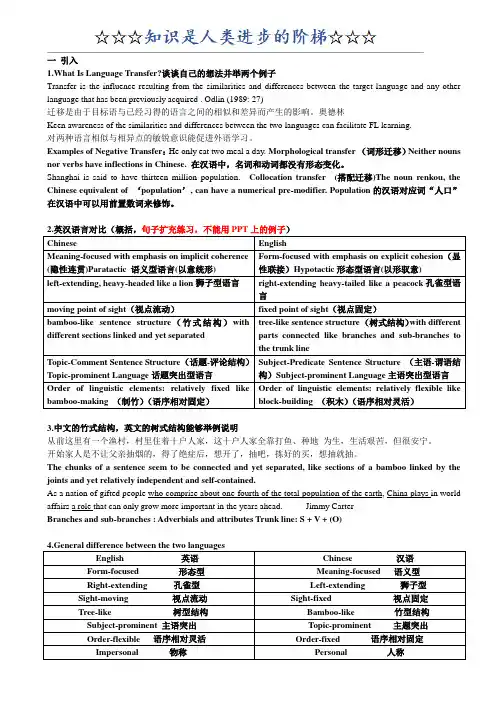
一引入1.What Is Language Transfer?谈谈自己的想法并举两个例子Transfer is the influence resulting from the similarities and differences between the target language and any other language that has been previously acquired . Odlin (1989: 27)迁移是由于目标语与已经习得的语言之间的相似和差异而产生的影响。
奥德林Keen awareness of the similarities and differences between the two languages can facilitate FL learning.对两种语言相似与相异点的敏锐意识能促进外语学习。
Examples of Negative Transfer:He only eat two meal a day. Morphological transfer (词形迁移)Neither nouns nor verbs have inflections in Chinese. 在汉语中,名词和动词都没有形态变化。
Shanghai is said to have thirteen million population. Collocation transfer (搭配迁移)The noun renkou, the Chinese equivalent of ‘population’, can have a numerical pre-modifier. Population的汉语对应词“人口”在汉语中可以用前置数词来修饰。
Chinese EnglishMeaning-focused with emphasis on implicit coherence (隐性连贯)Paratactic语义型语言(以意统形) Form-focused with emphasis on explicit cohesion(显性联接)Hypotactic形态型语言(以形驭意)left-extending, heavy-headed like a lion狮子型语言right-extending heavy-tailed like a peacock孔雀型语言moving point of sight(视点流动)fixed point of sight(视点固定)bamboo-like sentence structure(竹式结构)with different sections linked and yet separated tree-like sentence structure (树式结构)with different parts connected like branches and sub-branches to the trunk lineTopic-Comment Sentence Structure (话题-评论结构)Topic-prominent Language话题突出型语言Subject-Predicate Sentence Structure (主语-谓语结构)Subject-prominent Language主语突出型语言Order of linguistic elements: relatively fixed like bamboo-making (制竹)(语序相对固定)Order of linguistic elements: relatively flexible like block-building (积木)(语序相对灵活)3.中文的竹式结构,英文的树式结构能够举例说明从前这里有一个渔村,村里住着十户人家,这十户人家全靠打鱼、种地为生,生活艰苦,但很安宁。
英汉对比与翻译期末复习指南
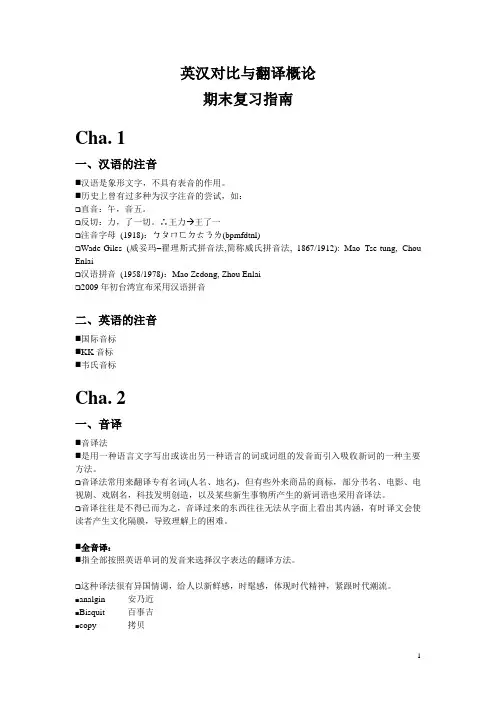
英汉对比与翻译概论期末复习指南Cha. 1一、汉语的注音⏹汉语是象形文字,不具有表音的作用。
⏹历史上曾有过多种为汉字注音的尝试,如:❑直音:午,音五。
❑反切:力,了一切。
∴王力→王了一❑注音字母(1918):ㄅㄆㄇㄈㄉㄊㄋㄌ(bpmfdtnl)❑Wade-Giles (威妥玛–翟理斯式拼音法,简称威氏拼音法, 1867/1912): Mao Tse-tung, Chou Enlai❑汉语拼音(1958/1978):Mao Zedong, Zhou Enlai❑2009年初台湾宣布采用汉语拼音二、英语的注音⏹国际音标⏹KK音标⏹韦氏音标Cha. 2一、音译⏹音译法⏹是用一种语言文字写出或读出另一种语言的词或词组的发音而引入吸收新词的一种主要方法。
❑音译法常用来翻译专有名词(人名、地名),但有些外来商品的商标,部分书名、电影、电视剧、戏剧名,科技发明创造,以及某些新生事物所产生的新词语也采用音译法。
❑音译往往是不得已而为之,音译过来的东西往往无法从字面上看出其内涵,有时译文会使读者产生文化隔膜,导致理解上的困难。
⏹全音译:⏹指全部按照英语单词的发音来选择汉字表达的翻译方法。
❑这种译法很有异国情调,给人以新鲜感,时髦感,体现时代精神,紧跟时代潮流。
⏹analgin 安乃近⏹Bisquit 百事吉⏹copy 拷贝⏹Delicious 得利斯⏹Fiyta 飞亚达⏹Kodak 柯达⏹Ford 福特⏹Lactov 乐口福⏹Lucky 乐凯⏹Paloma 百乐满⏹party 派对⏹Polaroid 宝利莱⏹salad 色拉⏹shampoo 香波⏹toast 吐司⏹部分音译部分意译:⏹指在英语名词音译前或后再加上说明性文字,让人们知道该名称的性质是什么。
❑但随着该词的流行和接受程度,意译部分逐渐淘汰,弃而不用。
⏹B owling 保龄球⏹Cookies 曲奇饼⏹Clean & Clear 可伶可俐洗面奶⏹Disco 迪斯科舞⏹Jacket 夹克衫⏹Golf 高尔夫球⏹Good 古德面包⏹Head & Shoulders 海飞丝洗发露⏹Jeep 吉普车⏹More 摩尔香烟⏹Pizza 比萨饼⏹Safeguard 舒肤佳香皂⏹Sardine 沙丁鱼罐头⏹Toffee 太妃糖⏹Top 脱普洗头膏⏹Sony 索尼电器⏹Waltz 华尔兹舞⏹约定俗成的译名不应重新改译,最好尽量保留原译名。
英汉语言对比_华中科技大学中国大学mooc课后章节答案期末考试题库2023年
英汉语言对比_华中科技大学中国大学mooc课后章节答案期末考试题库2023年1.How are you Lennox? Good to see you ______ and about.参考答案:up2.英语的句子书面上以句号、问号或感叹号结尾,句子的界限非常清晰。
参考答案:正确3.古英语词汇在现代英语词汇中无足轻重。
参考答案:错误4.______进入英国,使得英语越来越规范。
参考答案:印刷术5.声母和韵母相同的字、词,其意义往往靠不同的______来区别。
参考答案:声调6.I cannot care less about the result of the interview. 该句的译文是______?参考答案:我一点也不在乎这次面试的结果。
7.汉语的被动式所表达的一般是不如意或不企望的事情参考答案:正确8.I'd do it with pleasure, only that I am too busy. 该句的译文是______?参考答案:我很高兴去做这件事,只是我太忙了做不了。
9.隐喻类似于传统意义上修辞学中的暗喻,指人们用一个具体的概念来理解另一个抽象概念的方式。
参考答案:正确10.英语的结构被动句要比汉语结构被动使用频率高得多。
参考答案:正确11.汉语中的婚姻表达比英语中包含更多的容器隐喻。
参考答案:正确12.“他最近情绪很低落。
"该句的译文是 He's been so ______ lately.参考答案:down13.“望子成龙”的译文是“to hope one's children will ______”。
参考答案:have a bright future14.“pull one's leg”的译文是______?参考答案:开玩笑15.“喜结连理,百年好合。
”该句中包含的婚姻隐喻是______?参考答案:婚姻是连接16.连动结构中所有动词与同一主语构成主谓关系。
汉英语言对比重点知识
对比分析在外语教学中可以用于什么方面?摹声格与On omato poeia的差异(汉语的摹声格与Onomatopoeia的区别)1.以语音的形式对自然界发出的声音进行直接的摹拟就是汉语的摹声格与英语的On omato poeia。
2.汉语的摹声格使用迭音词或迭音结构,大多表达为四种模式:AA,ABB,AABB,ABAB.英语的Onomatop oeia没有这种叠音形式,英语的拟声词绝大部分是单音节词,这与汉语正好相反。
3.差异:1、不同语言的民族各自固有的语音系统影响或限制。
2、在摹拟相同的自然声响时,摹拟的角度不同。
3、“摹拟”过程中,加上自己民族的主观色彩或凭借自己的想象力去自由发挥,极力拓展,以便使各自的语言更为形象,生动,逼真的结果。
双声,叠韵与All itera t ion, Assonance的辨别汉英隐喻的共性、个性分析-来源(汉英隐喻共性和个性产生的原则)1.汉英隐喻的共性来源于人类隐喻思维的共性。
人类在认识和了解世界的过程中,总是不断地以已知经验去认知未知的自然现象。
对未知事物的理解也总是建立在已知事物的基础上。
“未知事物”究竟是什么,只有在同已知事物的对比中找出相似点,才能弄清。
这便是隐喻思维逐渐形成的过程,它实际上包含了一个类比、推理的思维过程。
这一过程逐渐模式化,最后形成了隐喻这一人类的思维方式。
2.地域民族不同,社会文化,政治宗教,风土人情的差异以及时代进程的快慢会使人类获取的直接经验有所不同,因而人们对一事物与它事物间的联想就不同。
汉英隐喻个性产生。
隐喻:当今认知语言学研究中的一个重要术语,概念和理论。
汉英隐喻都是一种比喻方式,是根据联想,抓住不同事物的相似性,用它事物来阐明所要描绘的事物。
英汉语言对比
3. 1. 1 英语重形合,汉语重意合
英语重形合(hypotaxis)是指英语语言符号之间有较强
的逻辑关系;汉语重意合(parataxis)是指汉语句子主要通
过字词的意义连结起来。汉字起源于象形文字,文字的图
形表示其意义,并引起意义上的联想,发展形象思维;英
语是拼音文字,字母是基本的文字表达符号,词的拼写与
英汉语言对比
6
翻译是两种语际间的转换、是两种文化信 息间的转换。语言不是静止不变的,是随着社 会实践的不断发展而发展的。词的意义、语言 表达也是如此。语言是活的,运用语言的人也 要灵活对待它。“实践,认识,再实践,再认识, 这种形式,循环往复以至无穷,而实践和认识 之每一循环的内容,都比较地进到了高一级的 程度。这就是辩证唯物论的全部认识论”。翻译 也是这样。
英汉语言对比
11
3. 1. 2 英语爱化零为整,汉语喜化整为零
“英国人写文章往往化零为整,而中国人则
化整为零”(王力)。这说明英汉两种语言写作在篇
3. 4 英汉句意表达对比
3.4.1 英汉都有增补与省略 3.4.2 英汉都有词类转换 3.4.3 英汉都有巧妙重复 3.4.4 英汉都受上下文制约选择词义
第三章综合英汉练语习言及对比参考答案
课堂互动1 课堂互动2
课堂互动3
课堂互动4
1.词句表达 2.语序调整 3.衔接表达
--end
退出
第三章
英汉语言对比
英汉语言对比
3
不同语言间的差异不仅表现在语言、词汇和 语法这些语言形式上,而且表现在语言文化特征 上。语言文化特征不仅涉及到一种语言所代表民 族的心理意识、风土人情、宗教信仰和历史传统 等因素,而且涉及到历史文化、地域文化、习俗 文化、宗教文化等方面,其范围是广泛庞杂的、 内涵是多采丰富的。
英汉语言对比_华中科技大学中国大学mooc课后章节答案期末考试题库2023年
英汉语言对比_华中科技大学中国大学mooc课后章节答案期末考试题库2023年1.“车位已满”的正确英译为______?答案:Occupied2.下列英语词汇中哪一个不是从汉语借入的?答案:tornado3.“True blue will never stain”一句话中“True blue”表示_______答案:忠诚可靠的人4.英语中的拟声词跟汉语的相比,数量______。
答案:更多5.下列哪一个植物词语在英语中象征春天?答案:daisy6.英语姓氏中的前缀O'代表什么含义?答案:某人的后裔7.哪一个选项不是汉语姓氏的来源?答案:体型8."Long time no see."属于哪种借词方式?洋泾浜英语9.下列选项中哪一个词表示“卑劣、胆怯的人”?答案:yellow dog10.“bird dog”一词的意思为_______。
答案:寻找新人才的人、猎头11.“white feather”一词的比喻意义是_______。
答案:胆小12.汉语的大多数的抑扬顿挫是通过_______来实现的。
声调13.“我喜欢徒步,他也喜欢徒步”的正确译文是:_______?答案:I like hiking, so does he.14.We are told that he will come tonight, and if so, our meeting will be heldtomorrow.该句中的替代形式是_______?答案:分句性替代15.英语为______语言,因此需要______重复.答案:形合;避免16.Apple has just luanched its new iPhone and this gadget can be chargedwirelessly. 该句使用的是______变换手法。
答案:上下义词17.To err is human; to forgive, divine.该句中的省略形式是_______?答案:动词省略18.“blue book”的意思是_______。
- 1、下载文档前请自行甄别文档内容的完整性,平台不提供额外的编辑、内容补充、找答案等附加服务。
- 2、"仅部分预览"的文档,不可在线预览部分如存在完整性等问题,可反馈申请退款(可完整预览的文档不适用该条件!)。
- 3、如文档侵犯您的权益,请联系客服反馈,我们会尽快为您处理(人工客服工作时间:9:00-18:30)。
综合语:A synthetic language is “characterized by frequent and systematic use of inflected forms to express grammatical relationships”.
分析语:An analytic language is “characterized by a relatively frequent use of function words, auxiliary verbs, and changes in word order to express syntactic relations, rather than of inflected forms.”
名词化:Nominalization refers to the replacement of clauses,which contain finite verbs,with complex structures consisting of nouns and noun adjuncts.
词化:lexicalization refers to the device that one word is used to express the meaning that one clause or phrase denotes.
形合:The dependent or subordinate construction or relationship of clauses with connectives ,for example,I shall despair if you don’t come.
意合:The arranging of clauses one after the other without connectives showing the relation between them.
1.英语、汉语语篇模式
英语:演绎式是英语语篇结构的基本模式。
英国人习惯开门见山,一落笔就点明主题、交代要点。
然后再逐层细叙、分析推理,较常按照从一般到细节、从概括到具体、从整体到个体的原则。
汉语:比较注重话题,注重意识流,注重事理和先后顺序,常常采用非演绎式的、往往是领悟式的归纳型或是螺旋式的思维模式
英译汉时破局重组化繁为简
Eg ;In the doorway lay at least twelve umbrellas of all sizes and colors.
门口放着一推雨伞,少说也有十二把,五颜六色,大小不一。
门口放着至少有十二把五颜六色、大小不一的雨伞。
2 形合意合表现在哪些方面
英语形合:关系词和连接词介词形态变化形式等其他连接手段
汉语意合:语序反复、排比、对偶、对照紧缩局四字格
3英语句子扩展表现在那些方面
增加句子修饰语
扩展基本句型的成分
基本句型的组合
4名词作形容词举例注意那些方面
报刊标题Job Opportunity Discrimination
科技文章space shuttle flight test program
注意方面
名词定语与被修饰词之间存在种种不同的语义关系
名词定语与被修饰词之间的语义关系常常不能从字面上判断出来也不能简单的把前一个名词理解为修饰语而已
要正确理解其含义,往往还要联系其语境甚至社会文化背景知识
过分堆积名词,认为这会使语言失去活力,缺乏动态感,有时还会造成语义含混,甚至产生歧义
几个名词连用,也会让人分不清修饰词与被修饰词,甚至分不清词类。
(Eg company grants increase)
用名词做定语,其意义和功能有时相当于形容词作定语
5英汉句子扩展机制是什么
英语句子呈现句首封闭、句尾开放的特征(Right Branching)。
汉语句子呈现句首开发、句尾收缩的特征。
(Left Branching)。
